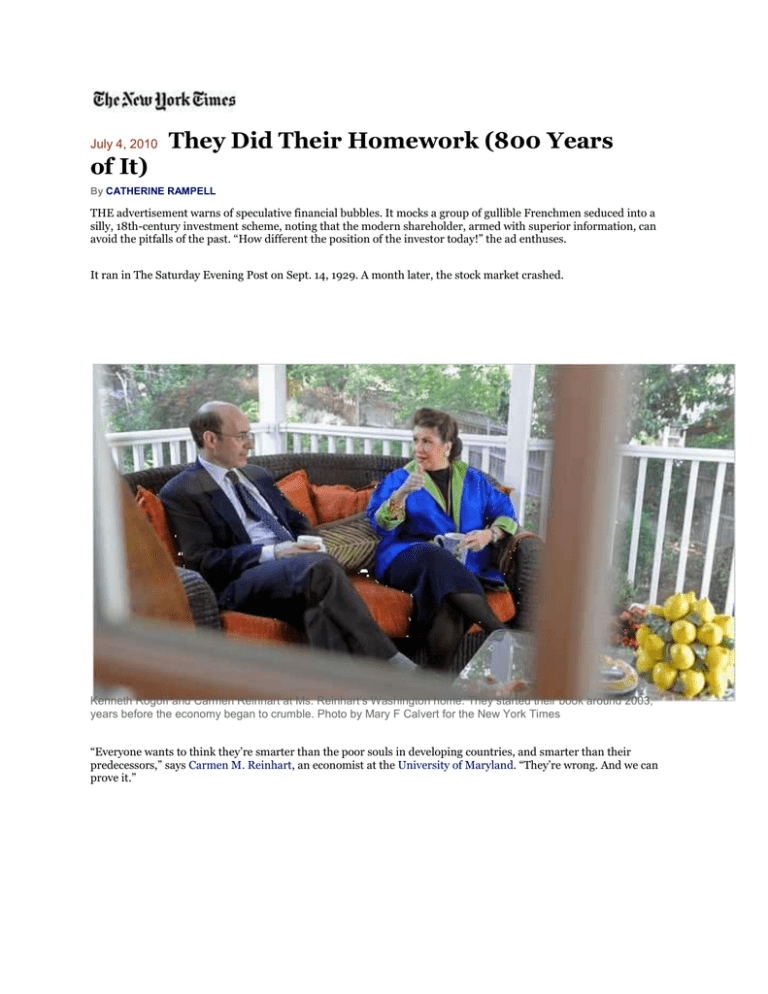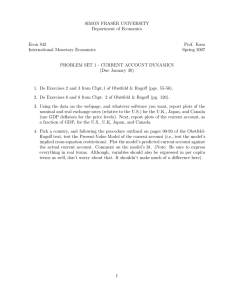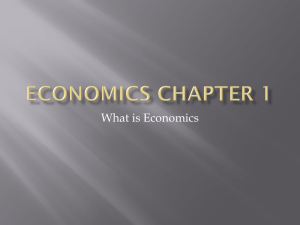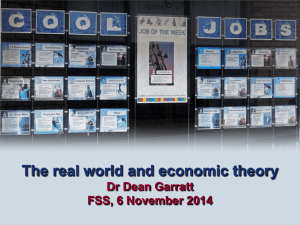They Did Their Homework (800 Years of It) July 4, 2010
advertisement

July 4, 2010 They Did Their Homework (800 Years of It) By CATHERINE RAMPELL THE advertisement warns of speculative financial bubbles. It mocks a group of gullible Frenchmen seduced into a silly, 18th-century investment scheme, noting that the modern shareholder, armed with superior information, can avoid the pitfalls of the past. “How different the position of the investor today!” the ad enthuses. It ran in The Saturday Evening Post on Sept. 14, 1929. A month later, the stock market crashed. Kenneth Rogoff and Carmen Reinhart at Ms. Reinhart’s Washington home. They started their book around 2003, years before the economy began to crumble. Photo by Mary F Calvert for the New York Times “Everyone wants to think they’re smarter than the poor souls in developing countries, and smarter than their predecessors,” says Carmen M. Reinhart, an economist at the University of Maryland. “They’re wrong. And we can prove it.” Like a pair of financial sleuths, Ms. Reinhart and her collaborator from Harvard, Kenneth S. Rogoff, have spent years investigating wreckage scattered across documents from nearly a millennium of economic crises and collapses. They have wandered the basements of rare-book libraries, riffled through monks’ yellowed journals and begged central banks worldwide for centuries-old debt records. And they have manually entered their findings, digit by digit, into one of the biggest spreadsheets you’ve ever seen. Their handiwork is contained in their recent best seller, “This Time Is Different,” a quantitative reconstruction of hundreds of historical episodes in which perfectly smart people made perfectly disastrous decisions. It is a panoramic opus, both geographically and temporally, covering crises from 66 countries over the last 800 years. The book, and Ms. Reinhart’s and Mr. Rogoff’s own professional journeys as economists, zero in on some of the broader shortcomings of their trade — thrown into harsh relief by economists’ widespread failure to anticipate or address the financial crisis that began in 2007. “The mainstream of academic research in macroeconomics puts theoretical coherence and elegance first, and investigating the data second,” says Mr. Rogoff. For that reason, he says, much of the profession’s celebrated work “was not terribly useful in either predicting the financial crisis, or in assessing how it would it play out once it happened.” “People almost pride themselves on not paying attention to current events,” he says. In the past, other economists often took the same empirical approach as the Reinhart-Rogoff team. But this approach fell into disfavor over the last few decades as economists glorified financial papers that were theory-rich and datapoor. Much of that theory-driven work, critics say, is built on the same disassembled and reassembled sets of data points — generally from just the last 25 years or so and from the same handful of rich countries — that quants have whisked into ever more dazzling and complicated mathematical formations. But in the wake of the recent crisis, a few economists — like Professors Reinhart and Rogoff, and other like-minded colleagues like Barry Eichengreen and Alan Taylor — have been encouraging others in their field to look beyond hermetically sealed theoretical models and into the historical record. “There is so much inbredness in this profession,” says Ms. Reinhart. “They all read the same sources. They all use the same data sets. They all talk to the same people. There is endless extrapolation on extrapolation on extrapolation, and for years that is what has been rewarded.” ONE of Ken Rogoff’s favorite economics jokes — yes, there are economics jokes — is “the one about the lamppost”: A drunk on his way home from a bar one night realizes that he has dropped his keys. He gets down on his hands and knees and starts groping around beneath a lamppost. A policeman asks what he’s doing. “I lost my keys in the park,” says the drunk. “Then why are you looking for them under the lamppost?” asks the puzzled cop. “Because,” says the drunk, “that’s where the light is.” Photo by Mary F Calvert for the New York Times Mr. Rogoff, 57, has spent a lifetime exploring places and ideas off the beaten track. Tall, thin and bespectacled, he grew up in Rochester. There, he attended a “tough inner-city school,” where his “true liberal parents” — a radiologist and a librarian — sent him so he would be exposed to students from a variety of social and economic classes. He received a chess set for his 13th birthday, and he quickly discovered that he was something of a prodigy, a fact he decided to hide so he wouldn’t get beaten up in the lunchroom. “I think chess may be a relatively cool thing for kids to do now, on par with soccer or other sports,” he says. “It really wasn’t then.” Soon, he began traveling alone to competitions around the United States, paying his way with his prize winnings. He earned the rank of American “master” by the age of 14, was a New York State Open champion and soon became a “senior master,” the highest national title. When he was 16, he left home against his parents’ wishes to become a professional chess player in Europe. He enrolled fleetingly in high schools in London and Sarajevo, Yugoslavia, but rarely attended. “I wasn’t quite sure what I was supposed to be doing,” he recalls. He spent the next 18 months or so wandering to competitions around Europe, supporting himself with winnings and by participating in exhibitions in which he played dozens of opponents simultaneously, sometimes while wearing a blindfold. Occasionally, he slept in five-star hotels, but other nights, when his prize winnings thinned, he crashed in grimy train stations. He had few friends, and spent most of his time alone, studying chess and analyzing previous games. Cleancut and favoring a coat and tie these days, he described himself as a ragged “hippie” during his time in Europe. He also found life in Eastern Europe friendly but strained, he says, throttled by black markets, scarcity and unmet government promises. After much hand-wringing, he decided to return to the United States to attend Yale, which overlooked his threadbare high school transcript. He considered majoring in Russian until Jeremy Bulow, a classmate who is now an economics professor at Stanford, began evangelizing about economics. Mr. Rogoff took an econometrics course, reveling in its precision and rigor, and went on to focus on comparative economic systems. He interrupted a brief stint in a graduate program in economics at the Massachusetts Institute of Technology to prepare for the world chess championships, which were held only every three years. After becoming an “international grandmaster,” the highest title awarded in chess, when he was 25, he decided to quit chess entirely and to return to M.I.T. He did so because he had snared the grandmaster title and because he realized that he would probably never be ranked No. 1. He says it took him a long time to get over the game, and the euphoric, almost omnipotent highs of his past victories. “To this day I get letters, maybe every two years, from top players asking me: ‘How do I quit? I want to quit like you did, and I can’t figure out how to do it,’ ” he says. “I tell them that it’s hard to go from being at the top of a field, because you really feel that way when you’re playing chess and winning, to being at the bottom — and they need to prepare themselves for that.” He returned to M.I.T., rushed through what he acknowledges was a mediocre doctoral dissertation, and then became a researcher at the Federal Reserve — where he said he had good role models who taught him how to be, at last, “professional” and “serious.” Teaching stints followed, before the International Monetary Fund chose him as its chief economist in 2001. It was at the I.M.F. that he began collaborating with a relatively unfamiliar economist named Carmen Reinhart, whom he appointed as his deputy after admiring her work from afar. MS. REINHART, 54, is hardly a household name. And, unlike Mr. Rogoff, she has never been hired by an Ivy League school. But measured by how often her work is cited by colleagues and others, this woman whom several colleagues describe as a “firecracker” is, by a long shot, the most influential female economist in the world. Like Mr. Rogoff, she took a circuitous route to her present position. Born in Havana as Carmen Castellanos, she is quick-witted and favors bright, boldly printed blouses and blazers. As a girl, she memorized the lore of pirates and their trade routes, which she says was her first exposure to the idea that economic fortunes — and state revenue in particular — “can suddenly disappear without warning.” She also lived with more personal financial and social instability. After her family fled Havana for the United States with just three suitcases when she was 10, her father traded a comfortable living as an accountant for long, less lucrative hours as a carpenter. Her mother, who had never worked outside the home before, became a seamstress. “Most kids don’t grow up with that kind of real economic shock,” she says. “But I learned the value of scarcity, and even the sort of tensions between East and West. And at a very early age that had an imprint on me.” With a passion for art and literature — even today, her academic papers pun on the writings of Gabriel García Márquez — she enrolled in a two-year college in Miami, intending to study fashion merchandising. Then, on a whim, she took an economics course and got hooked. When she went to Florida International University to study economics, she met Peter Montiel, an M.I.T. graduate who was teaching there. Recognizing her talent, he helped her apply to a top-tier graduate program in economics, at Columbia University. At Columbia, she met her future husband, Vincent Reinhart, who is now an occasional co-author with her. They married while in graduate school, and she quit school before writing her dissertation to try to make some money on Wall Street. “We were newlyweds, and neither of us had a penny to our name,” she says. She left school so that they “could have nice things and a house, the kind of things I imagined a family should have.” She spent a few years at Bear Stearns, including one as chief economist, before deciding to finish her graduate work at Columbia and return to her true love: data mining. “I have a talent for rounding up data like cattle, all over the plain,” she says. After earning her doctorate in 1988, Ms. Reinhart started work at the I.M.F. “Carmen in many ways pioneered a bigger segment in economics, this push to look at history more,” says Mr. Rogoff, explaining why he chose her. “She was just so ahead of the curve.” She honed her knack for economic archaeology at the I.M.F., spending several years performing “checkups” on member countries to make sure they were in good economic health. While at the fund, she teamed up with Graciela Kaminsky, another member of that exceptionally rare species — the female economist — to write their seminal paper, “The Twin Crises.” The article looked at the interaction between banking and currency crises, and why contemporary theory couldn’t explain why those ugly events usually happened together. The paper bore one of Ms. Reinhart’s hallmarks: a vast web of data, compiled from 20 countries over several decades. In digging through old records and piecing together a vast puzzle of disconnected data points, her ultimate goal, in that paper and others, has always been “to see the forest,” she says, “and explain it.” Ms. Reinhart has bounced back and forth across the Beltway: she left the I.M.F. in Washington and began teaching in 1996 at the University of Maryland, from which Mr. Rogoff recruited her when he needed a deputy at the I.M.F. in 2001. When she left that post, she returned to the university. Despite the large following that her work has drawn, she says she feels that the heavyweights of her profession have looked down upon her research as useful but too simplistic. “You know, everything is simple when it’s clearly explained,” she contends. “It’s like with Sherlock Holmes. He goes through this incredible deductive process from Point A to Point B, and by the time he explains everything, it makes so much sense that it sounds obvious and simple. It doesn’t sound clever anymore.” But, she says, “economists love being clever.” “THIS TIME IS DIFFERENT” was published last September, just as the nation was coming to grips with a financial crisis that had nearly spiraled out of control and a job market that lay in tatters. Despite bailout after bailout, stimulus after stimulus, economic armageddon still seemed nigh. Given this backdrop, it’s perhaps not surprising that a book arguing that the crisis was a rerun, and not a wholly novel catastrophe, managed to become a best seller. So far, nearly 100,000 copies have been sold, according to its publisher, the Princeton University Press. Still, its authors laugh when asked about the book’s opportune timing. “We didn’t start the book thinking that, ‘Oh, in exactly seven years there will be a housing bust leading to a global financial crisis that will be the perfect environment in which to sell this giant book,’ ” says Mr. Rogoff. “But I suppose the way things work, we expected that whenever the book came out there would probably be some crisis or other to peg it to.” They began the book around 2003, not long after Mr. Rogoff lured Ms. Reinhart back to the I.M.F. to serve as his deputy. The pair had already been collaborating fruitfully, finding that her dogged pursuit of data and his more theoretical public policy eye were well matched. Although their book is studiously nonideological, and is more focused on patterns than on policy recommendations, it has become fodder for the highly charged debate over the recent growth in government debt. To bolster their calls for tightened government spending, budget hawks have cited the book’s warnings about the perils of escalating public and private debt. Left-leaning analysts have been quick to take issue with that argument, saying that fiscal austerity perpetuates joblessness, and have been attacking economists associated with it. Mr. Rogoff, because of his time at the I.M.F., has also come under fire. In the years before and during Mr. Rogoff’s tenure, critics including the prominent economist Joseph Stiglitz accused the I.M.F. of having a cold-hearted, doctrinaire approach to its work in poorer countries. Some of that criticism still clings to Mr. Rogoff. For his part, he contends that the I.M.F. did what it could for countries with intractable problems, and that the critics’ approaches would have made troubled economies even weaker. Perhaps because “This Time Is Different” is empirical rather than proscriptive, it has defied categorization. The New York Times Op-Ed columnist David Brooks, for example, praised the book as “the best explanation of the crisis” but referred to it as a history book, rather than a work of economic analysis, since it is “almost entirely devoid of theory.” (The implication being, of course, that genuine “economic analysis” must be hypertheoretical.) Of course, it’s not as if history is an entirely new ingredient in economic study. There have been other vibrant historical recountings of financial crises, including “Manias, Panics and Crashes,” the 1978 book by Charles Kindleberger. Such books have typically been narrative, though, unlike the data-intensive “This Time Is Different.” But even in its quantitative perspective and breadth, the book still stands on the shoulders of an economic classic, “A Monetary History of the United States: 1867-1960,” written by another great male-and-female pair of economists, Milton Friedman and Anna Jacobson Schwartz. “What Friedman and Schwartz did for the U.S. was heroic,” says Ms. Reinhart. “Ken and I have benefited from the use of the Internet to track down books, sources and experts to help us with our work. Friedman and Schwartz did not.” While Professors Reinhart and Rogoff may have had technological advantages in their research, they weren’t able to outsource much of the number-crunching to graduate students — in part because they wanted to be able to stay close to the data themselves, but also because few students are interested in or trained for that kind of work. The economics profession generally began turning away from empirical work in the early 1970s. Around that time, economists fell in love with theoretical constructs, a shift that has no single explanation. Some analysts say it may reflect economists’ desire to be seen as scientists who describe and discover universal laws of nature. “Economists have physics envy,” says Richard Sylla, a financial historian at the Stern School of Business at New York University. He argues that Paul Samuelson, the Nobel laureate whom many credit with endowing economists with a mathematical tool kit, “showed that a lot of physical theories and concepts had economic analogs.” Since that time, he says, “economists like to think that there is some physical, stable state of the world if they get the model right.” But, he adds, “there is really no such thing as a stable state for the economy.” Others suggest that incentives for young economists to publish in journals and gain tenure predispose them to pursue technical wizardry over deep empirical research and to choose narrow slices of topics. Historians, on the other hand, are more likely to focus on more comprehensive subjects — that is, the material for books — that reflect a deeply experienced, broadly informed sense of judgment. “They say historians peak in their 50s, once they’ve accumulated enough knowledge and wisdom to know what to look for,” says Mr. Rogoff. “By contrast, economists seem to peak much earlier. It’s hard to find an important paper written by an economist after 40.” MICROECONOMICS — the field that focuses on smaller units like households and workers, as opposed to big-picture questions about how national economies function — has embraced real-world data-mining. (Think “Freakonomics.”) Macroeconomics has been slower to change, but the popular success of “This Time Is Different” and related work seems to be changing how macro practitioners approach their craft. It has also changed how policy makers think about their own mission. Mr. Rogoff says a senior official in the Japanese finance ministry was offended at the suggestion in “This Time Is Different” that Japan had once defaulted on its debt and sent him an angry letter demanding a retraction. Mr. Rogoff sent him a 1942 front-page article in The Times documenting the forgotten default. “Thank you,” the official wrote in apology, “for teaching the Japanese something about our own country.”




